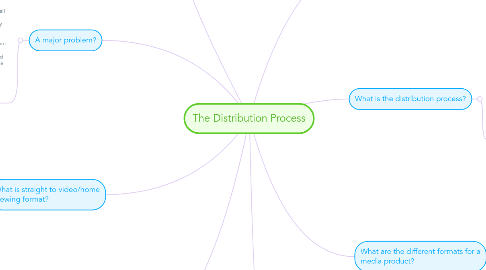The Distribution Process
by Dominic Bramley

1. What are examples of film distributors?
1.1. -Warner Bros. -20th Century Fox. -Paramount Pictures. -Universal Pictures. -Sony Pictures Entertainment (earlier known as Columiba-Tristar Pictures). -Walt Disney Pictures. These six examples are often referred to as 'The Big Six' as they are the main film production companies and distributors who dominate the media. Other examples of film distributors include: - Lionsgate. -Film4.
2. What is straight to video/home viewing format?
2.1. This is when a film is simply released straight into a home viewing format. This means it misses out the exhibition stage in which the audience can view it in a cinema. This is only usually the case with more lower-scale films. Productions produced by conglomerates more often want to maximise their profits through ticket sales. A famous example of this occurrence is the 'One In The Chamber' film that was released straight on to DVD format in August 21st 2012.
3. A major problem?
3.1. The constantly developing internet is an ongoing problem which film distributors are faced with. It is now easier than ever for potential audience members to illegally stream movies. This has a major impact at all stages of distribution. Firstly, there is an issue that some films may be leaked before they are realsied in the cinema. This subsequently means that people will not be as inclined to watch it when it comes to exhibition. Secondly, there has been a rapid decrease in the number of DVD bought due to this illegal streaming online. All this therefore means that the distributors lose out on money. Due to this streaming, it is difficult for the BBFC age regulations to be adhered to. (link).
4. What is standard release?
4.1. Standard release is the process that the majority of productions conform to. As the name suggests it is the 'standard' way in which films are distributed. Standard release involves a film being first shown in the cinema before a DVD/Blue-ray copy is released around 16 weeks later for home viewing.
5. What is the distribution process?
5.1. The distribution process quite simply is the way in which a film is made available for an audience member to watch. This process happens after the three production stages, as outlined on another blog. It is usually the responsibility of film distributors to get directly involved with this process. These film distributors may discuss marketing strategies for distribution, on what formats the film should be released, the release date and just about anything else related to the exporting of films.
6. What are the different formats for a media product?
6.1. There are various formats that all distribution companies should consider when releasing their product, these include: cinema release, releasing to the TV or for personal home viewing (DVD, Blue-ray, video on demand or download).
7. What is simultaneous release?
7.1. Simultaneous release is the name given to a relatively new media distribution method. The method involves releasing the media product on to all necessary formats in one go. This defeats the traditional method of it first being shown in cinemas, then on DVD. The first ever stimultaneous released film was 'ERM' in July 2005. It was released theatrically, on DVD and on the Internet all on the same day. Some other noteworthy examples include the film 'Bubble' and 'The Road to Guantanamo'. Simultaneous release allows the audience to best choose the medium that can satisfy their needs.
8. What is self-distribution?
8.1. Self-distribution is the process whereby a production is distributed by a person themselves and involves no assistance from a third party distributor company. The process of self-distribution is still a relatively new concept in the ever-developing world of technological advancements. Many people chose to self-distribute through the forms of YouTube and social media sites because it allows for the potential of a global audience.


